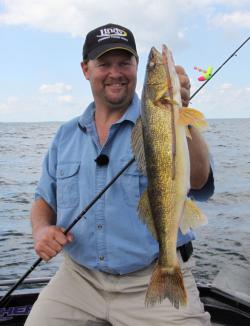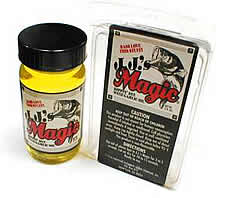NOAA Great White Shark Study Offers Optimistic Outlook
From the 90’s onward, NOAA scientists say, white shark numbers have slowly increased, mostly thanks to limited harvest.
Studies including hook-and-line captures indicate white sharks are recovering to safe numbers in Atlantic Waters off the U.S. coast.
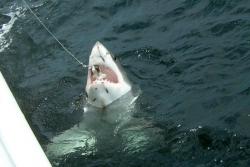
Great White Shark
White sharks are among the largest, most widespread apex predators in the ocean, but are also among the most vulnerable. A new study, the most comprehensive ever on seasonal distribution patterns and historic trends in abundance of white sharks (Carcharodon carcharias) in the western North Atlantic Ocean, used records compiled over more than 200 years to update knowledge and fill in gaps in information about this species.
Scientists from NOAA Fisheries and colleagues added recent unpublished records to previously published data to present a broad picture of 649 confirmed white shark records obtained between 1800 and 2010, the largest white shark dataset ever compiled for the region. Their study was published June 11 in the journal PLOS ONE.
“White sharks in the Northwest Atlantic are like a big jigsaw puzzle, where each year we are given only a handful of pieces,” said Tobey Curtis, a shark researcher at NOAA’s Greater Atlantic Regional Fisheries Office in Gloucester, Mass. and lead author of the study. “After decades of effort by a lot of researchers, we finally have enough puzzle pieces for a picture to emerge on distribution and abundance patterns. We are pleased to see signs of population recovery.”
Among the findings: White sharks occur primarily between Massachusetts and New Jersey during the summer, off Florida during winter, and with a broad distribution along the U.S. East Coast during spring and fall. The sharks are much more common along the coast than in offshore waters. The annual north-south distribution shift of the population is driven by environmental preferences, such as water temperature, and the availability of prey. In recent years, white sharks have been increasingly associated with the return of gray seal colonies off the coast of Massachusetts.
Many whites travel north in summer to waters off New England, south to waters off Florida in winter.
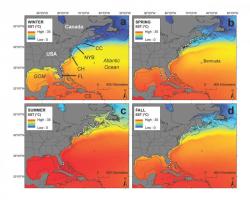
Great White Shark Movemen
“White sharks possess life history traits that make them vulnerable to exploitation,” said Nancy Kohler, chief of the Apex Predators Program at NOAA’s Northeast Fisheries Science Center (NEFSC) and a study co-author. “These sharks can live 70 years or more, mature late, and do not produce many young. Their status and highly valued jaws and fins have made them the target of recreational and trophy fisheries in areas where their populations are not protected.”
Opportunistic capture and sighting records remain the primary source of information on this species. The updated information in this study is aimed at improving the conservation and management of white sharks both regionally and internationally, and providing a new baseline for future study.
This study updates understanding of white shark relative abundance trends, seasonal distribution, habitat use, and fisheries interactions, most of which occur with rod and reel, longline, and gillnet gear. White shark records were collected from landings data, commercial fishery observer programs, recreational tournament information, scientific research surveys, commercial and recreational fishermen, and other sources. The records were further classified, based on biological information such as length and life stage – neonate, young of the year, juvenile, or mature. Distribution patterns of each life stage were examined.
In the 1970s and 1980s, relative abundance data indicated that white shark populations declined, likely due to expanding commercial and recreational shark fisheries. However, from the early 1990s onward, abundance has increased.
“Both the declines and, more notably, the increases in abundance seen in our study were supported by multiple data sources” said Cami McCandless, a biologist in the NEFSC’s Apex Predators Program and a study co-author. “The increase in relative abundance is likely due, in part, to the implementation of management measures. The U.S. has managed its shark fisheries since 1993, and banned both commercial and recreational harvesting of white sharks in 1997.”
Sightings of white sharks have increased considerably in recent years along much of the East Coast.
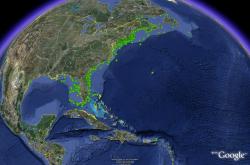
Great White Shark Sightings
While the overall distribution of white sharks is very broad, ranging from Newfoundland to the British Virgin Islands and from the Grand Banks to the Gulf of Mexico as far west as the Texas coast, 90 percent of the animals recorded in this study were found along the East Coast roughly between the Florida Keys and northern Caribbean Sea to Nova Scotia, Canada. The center of the distribution is in southern New England and the Mid-Atlantic Bight, where 66 percent of the sharks occurred.
Newborn white sharks, as small as 4.0 feet long, regularly occur off Long Island, New York, suggesting this area may provide nursery habitat. The largest shark in the study considered accurately measured was a female landed on Prince Edward Island, Canada, in August 1983. The animal measured 17.26 feet from the tip of its snout to the fork in its tail.
White sharks of all ages and sizes are present in continental shelf waters year-round, but their distribution varies by season. During winter, most white sharks are found off the northeast coast of Florida, the Florida Keys, and in the Gulf of Mexico offshore of Tampa Bay, Florida, where they have generally been considered rare. In spring, the distribution expands northward, and by summer most sharks occur in the waters off New York and southern New England, and around Cape Cod. In August some large juvenile and mature individuals reach Newfoundland and the Gulf of St. Lawrence, the northernmost limit of their range. During fall, most sharks remain in northern latitudes, but begin to shift southward in November and December.
Most of the sharks were found in water depths shallower than 330 feet, although they seem to use deeper and colder waters as their size increases. The authors note that, in general, “white sharks remain an uncommon and sparsely distributed predator in the Northwest Atlantic Ocean.”
“We have improved our understanding of white sharks in the Northwest Atlantic in recent years through field research and technology,” said Kohler. “But we still have many questions about life history, population structure and size, behavior, habitat preferences, feeding habits, movements, and migration.”
White sharks live 70 years or more and mature late, so are highly vulnerable to over-harvest despite their formidable predatory capabilities.

Great White Shark Mouth
Questions include when and where the sharks mate and give birth, their use of offshore habitats beyond the continental shelf, and whether the timings of white shark migrations in the Northwest Atlantic are similar to those in the Pacific and Indian Oceans. More observations, fishery captures and analyses of occasional specimens, along with tagging and telemetry studies, are needed to help answer these questions and improve conservation strategies.
In addition to Curtis, Kohler, and McCandless, study authors include Lisa Natanson and John Hoey from the NEFSC’s Narragansett Laboratory in Rhode Island; John Carlson from NOAA’s Southeast Fisheries Science Center Laboratory in Panama City, Florida; Greg Skomal of the Massachusetts Division of Marine Fisheries; George Burgess from the Florida Museum of Natural History at the University of Florida in Gainesville; and Harold “Wes” Pratt, Jr. from Mote Marine Laboratory’s Tropical Research Laboratory in Summerland Key, Florida, a former member of the NEFSC’s Apex Predators Program.
# # #
NOAA Fisheries Service is dedicated to protecting and preserving our nation’s living marine resources and their habitat through scientific research, management and enforcement. NOAA Fisheries Service provides effective stewardship of these resources for the benefit of the nation, supporting coastal communities that depend upon them, and helping to provide safe and healthy seafood to consumers and recreational opportunities for the American public.
NOAA’s mission is to understand and predict changes in the Earth’s environment, from the depths of the ocean to the surface of the sun, and to conserve and manage our coastal and marine resources. Join us on Facebook, Twitter and our other social media channels.
